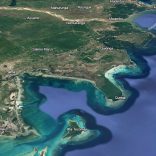Mozambique begins countrywide elephant aerial survey, seven years after last count
Mozambique: Maputo National Park reinforcing 145 km of fence to prevent elephants from escaping

Screen grab: Parque Nacional de Maputo
With the support of the Camões Institute, Maputo National Park is reinforcing its fence to prevent elephants from escaping and to curb conflict between humans and wildlife, park administrator Miguel Gonçalves told Lusa yesterday.
“The park is completely fenced, but the format we had was not efficient because the elephants, over the years, have been adapting and finding ways to break through [it],” Gonçalves explained.
The requalification and electrification of the 145-kilometre fence of the park, 25% completed so far, is being supported by the Camões – Portuguese Cultural Centre, and should be completed by December.
“[We are] adding electrified wires so that elephants cannot pull them or grab them with their trunks, because they will get electric shocks (…). We are also adding more wires to prevent them from breaking the fence,” he said.
Maputo National Park is one of five sites indicated as having “exceptional potential” for World Heritage status by the International Union for Conservation of Nature (IUCN), a decision to be made by UNESCO in July.
In a note dated June 2, IUCN, the official consultant on nature to the World Heritage Committee of the United Nations Educational, Scientific and Cultural Organization (UNESCO), said that if the intergovernmental committee follows its advice at its next meeting, the 47th session, to be held in Paris on July 6 and 16, “incredible landscapes, seascapes and areas of rich geodiversity and biodiversity” will receive this status.
These include, UICN says, “sites that protect up to 850,000 migratory birds, western chimpanzees and numerous coral reef fish”.
The history of the park, south of the Mozambican capital began in 1932, when it was a small hunting area, with elephants being one of the main targets. In 1969, acknowledgement of the importance of local biodiversity led to its classification as the Maputo Special Reserve.
After the decline caused by the civil war that followed independence, driven by the signing of a memorandum of understanding between the government and the Peace Parks Foundation in 2006, Maputo National Park has continued to grow since 2010, with the reintroduction and translocation of species.
“We brought a little over 5,000 animals of 14 different species, initially herbivores, and now we are reintroducing carnivores. We brought some cheetahs, we now have a population of hyenas and we may have to bring in more leopards (…). That is the plan,” explained the park’s administrator in a previous interview with Lusa in 2024.
With the emblematic giraffes and elephants that usually roam along the National Highway Number 1 (N1), the Maputo National Park combines the “sea and land” aspects, in a total area of 1,718 square kilometres. Officially, it was created on 7 December 2021, joining two historically established contiguous protected areas: the Maputo Special Reserve (1,040 km2 on the land component) and the Ponta do Ouro Partial Marine Reserve (678 km2).












Leave a Reply
Be the First to Comment!
You must be logged in to post a comment.
You must be logged in to post a comment.